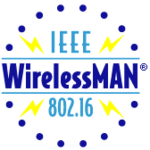IEEE 802.16

Working Group on Broadband Wireless Access Standards
|
IEEE 802.16 is a series of wireless broadband standards written by the Institute of Electrical and Electronics Engineers (IEEE). The IEEE Standards Board established a working group in 1999 to develop standards for broadband for wireless metropolitan area networks. The Workgroup is a unit of the IEEE 802 local area network and metropolitan area network standards committee.
Although the 802.16 family of standards is officially called WirelessMAN in IEEE, it has been commercialized under the name "WiMAX" (from "Worldwide Interoperability for Microwave Access") by the WiMAX Forum industry alliance. The Forum promotes and certifies compatibility and interoperability of products based on the IEEE 802.16 standards.
The 802.16e-2005 amendment version was announced as being deployed around the world in 2009. The version IEEE 802.16-2009 was amended by IEEE 802.16j-2009.
Projects publish draft and proposed standards with the letter "P" prefixed. Once a standard is ratified and published, that "P" gets dropped and replaced by a trailing dash and suffix year of publication.
The 802.16 standard essentially standardizes two aspects of the air interface – the physical layer (PHY) and the media access control (MAC) layer. This section provides an overview of the technology employed in these two layers in the mobile 802.16e specification.
802.16e uses scalable OFDMA to carry data, supporting channel bandwidths of between 1.25 MHz and 20 MHz, with up to 2048 subcarriers. It supports adaptive modulation and coding, so that in conditions of good signal, a highly efficient 64 QAM coding scheme is used, whereas when the signal is poorer, a more robust BPSK coding mechanism is used. In intermediate conditions, 16 QAM and QPSK can also be employed. Other PHY features include support for multiple-input multiple-output (MIMO) antennas in order to provide good non-line-of-sight propagation (NLOS) characteristics (or higher bandwidth) and hybrid automatic repeat request (HARQ) for good error correction performance.
...
Wikipedia
